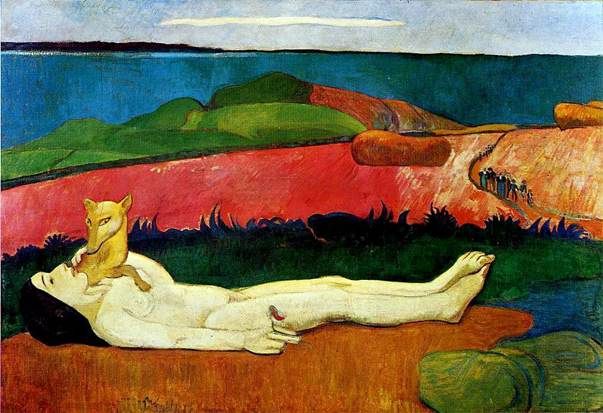
Cloth “Loss of Innocence” post-impressionist Paul Gauguin painted by the artist during the acquisition of a new “homeland” in Oceania – the island of his long-standing dream – Tahiti. It can not be said that the canvas fully embodies the spiritual state of the forty-three-year-old author. Viewing causes conflicting feelings. On the one hand, it is an indisputable masterpiece from the point of view of Gauguin’s creativity in world culture, on the other – naive narrative, ironic, funny in the sense of a caricatured interpretation of the philistine’s conclusions.
Let’s break the picture into its components. For a start about the technique of writing. It’s Impressionism, but it’s turned over by Paul and transformed by the whim of his own opinion about how Impressionism should look like in a Gogene. The artist has developed, or rather, acquired personal technique of performing multi-color paintings. This work demonstrates the absence of scattered strokes and abundant multicolor. Every detail, whether it is a hill, a field, the smooth surface of the sky, a woman, is generalized into fairly large color patches of pure color.
Gauguin, as usual, works with contrast. As required by Impressionism, the artist prescribed the shady nuances with an admixture of violet, avoiding the black pigment. But, unlike classical painting, “Loss of innocence” has a number of details with a clear outline of the silhouette, for example a dog that lies on the girl’s shoulder, the boundaries of the hills against the sky, etc. Such an outline does not contradict the technique of impression. The color solution of the picture, despite the abundance of red shades, is close to cold temperature.
The absence of highlights and semitones gave “Innocence” a planar character. There is incredible naivety in the work, both in the display and in the plot itself. Let’s switch now to the direct analysis of the narrative. According to the ancient tradition of Oceania, the deprivation of innocence was a ritual rite. The best friends of the groom obliged themselves to take part in the sacrament of the “first night” before the wedding, just before the beginning of the ceremony. In other words, the groom was the second after a group of guys called friends.
To perform this action, the bridegroom was taken far away from the village, and then returned to the victim. Judging by the work of Gauguin, the unfortunate ninny was forgotten in the same place where the rite of consecration took place in future wives. There she is, the crowd of friends in the background is leaving the young lady left without feeling. A faithful dog guards the faint of his mistress, and a fragile flower in the fingers of the “victim” hints at the loss of yesterday’s childhood.
The plot, despite the efforts of the author and the scene that has the right to live on the “wild” traditions in the opinion of a contemporary, turned out to be a ridiculous likeness of the illustration of “Crocodile”. Actually, the palette itself hints at the playful mood of the author.
 La perte de l’innocence – Paul Gauguin
La perte de l’innocence – Paul Gauguin Three Tahitians by Paul Gauguin
Three Tahitians by Paul Gauguin The Garden in the Snow by Paul Gauguin
The Garden in the Snow by Paul Gauguin Under the pandanian tree by Paul Gauguin
Under the pandanian tree by Paul Gauguin Early evening by Paul Gauguin
Early evening by Paul Gauguin Still Life with Sunflowers on the Chair by Paul Gauguin
Still Life with Sunflowers on the Chair by Paul Gauguin Landscape by Paul Gauguin
Landscape by Paul Gauguin Round dance of small brethren by Paul Gauguin
Round dance of small brethren by Paul Gauguin